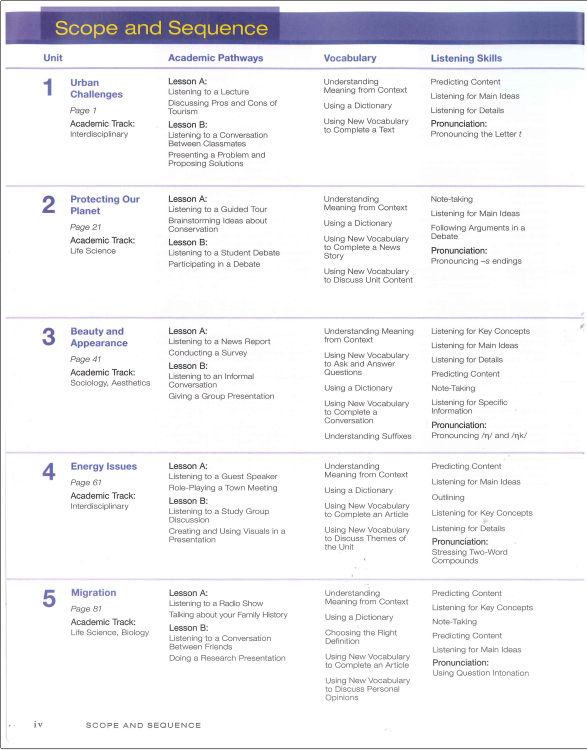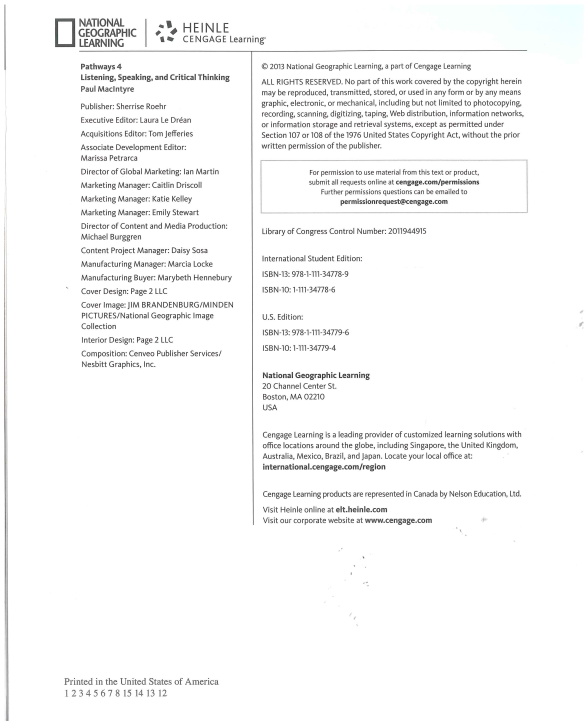


LISTENING AND TEXT
5–7, 10: Adapted from “Vanishing Venice,” by Cathy Newman: National Geographic Magazine, August 2009
14–16: Adapted from “The Singapore Solution,” by Mark Jacobson: National Geographic Magazine, January 2010
19: Adapted from “Urban Fishing Catches on in Rebounding Rivers” by James Owen: National Geographic Daily News, May 17, 2010
25: Adapted from “Forests of the Tide,” by Kennedy Warne: National Geographic Magazine, February 2007
26–27: Adapted from “Last One,” by Verlyn Klinkenborg: National Geographic Magazine, January 2009
34: Adapted from “Freshwater Hero,” National Geographic Web site
35: Adapted from “Wolf Wars” by Douglas Chadwick: National Geographic Magazine, March 2010
36–37: Adapted from “Hunters: For the Love of the Land,” by Robert M. Poole: National Geographic Magazine, November 2007
46–47: Adapted from “The Enigma of Beauty,” by Cathy Newman, National Geographic Magazine, January 2000
46–47: Adapted from “New ‘Golden’ Ratios for Facial Beauty,” by Pamela Pallett et al., National Institute of Health, January 25, 2010
56–57: Adapted from “Dreamweavers,” by Cathy Newman: National Geographic Web site, January 1, 2003
56–57: Adapted from “Artificial Spider Silk Could Be Used for Armor, More,” by Brian Handwerk: National Geographic Daily News, January 14, 2005
64: Adapted from “Is Another Deepwater Disaster Inevitable?,” by Joel K. Bourne, Jr.: National Geographic Magazine, October 2010
66–67: Adapted from “The Long Shadow of Chernobyl,” by Richard Stone: National Geographic Magazine, April 2006
84–87: Adapted from “Human Journey” by James Shreeve: National Geographic Magazine, March 2006
84–87: Adapted from “From Africa to Astoria by Way of Everywhere,” by James Shreeve: National Geographic Web site, August 17, 2009
96–97: Adapted from “Heartbreak on the Serengeti” by Robert M. Poole: National Geographic Magazine, February 2006
104: Adapted from “The Hadza,” by Michael Finkel: National Geographic Magazine, December 2009
106–107, 111: Adapted from “Bhutan’s Enlightened Experiment” by Brook Larmer: National Geographic Magazine, March 2008
110: Adapted from “Spread of the Amish” by National Geographic Staff: National Geographic Blog Central, July 8, 2009
114: Adapted from “Disappearing Languages: Enduring Voices Project,” National Geographic Web site, January 2011
115–117: Adapted from “Native Lands,” by Charles Bowden: National Geographic Magazine, August 2010
118: Adapted from “‘Spectacular’ Three-Cat Monolith Unearthed in Mexico,” by Ker Than: National Geographic Daily News, August 1, 2011
118: Adapted from “Machu Picchu’s Mysteries Continue to Lure Explorers,” by Kelly Hearn and Jason Golomb: National Geographic Web site
124, 126–127: Adapted from “Living it Up, Paying it Down,” by Mary McPeak: National Geographic Magazine, February 2005
144, 146–147: Adapted from “The Pollution Within,” by David Ewing Duncan: National Geographic Magazine, October 2006
156–157: Adapted from “Yosemite Climbing,” by Mark Jenkins: National Geographic Magazine, May 2011
165–167: Adapted from “Minds of Their Own,” by Virginia Morrell: National Geographic Magazine, March 2008
175: Adapted from “Young Chimp Outscores College Students in Memory Test,” by Malcolm Ritter: National Geographic News, December 3, 2007
176–177: Adapted from “Remember This” by Joshua Foer: National Geographic Magazine, November 2007
184, 186–187, 189: Adapted from “Food: How Altered?,” by Jennifer Ackerman: National Geographic Magazine, May 2002
184: Adapted from “Food Ark,” by Charles Siebert: National Geographic Magazine, July 2011
194–197: Adapted from “The Global Food Crisis: The End of Plenty,” by Joel K. Bourne, Jr.: National Geographic Magazine, June 2009
PHOTOS
1: Richard Levine/Alamy
3: Jodi Cobb/National Geographic Image Collection
3: Fritz Hoffmann/National Geographic Image Collection
4: Atelier Tekuto
4: Andy Z/Used under license from Shutterstock.com
4: Frances Roberts/Alamy
5: Jo Chambers/Shutterstock.com
6: Jodi Cobb/National Geographic Image Collection
9: Caitlin Mirra/Shutterstock.com
11: Mike Theiss/National Geographic Image Collection
12: Frans Lemmens/SuperStock
13: Matt Fletcher/Lonely Planet Images/Alamy
13: Rich Carey/Shutterstock.com
14: Caro/Alamy
14: Toshifumi Kitamura/AFP/Getty Images
16: Joseph Calev/Shutterstock.com
19: James Owen
21: Brian J. Skerry/National Geographic Image Collection
22: Pi-Lens/Shutterstock.com
22: Jason Lugo/iStockphoto.com
22–23: Beverly Joubert/National Geographic Image Collection
24: All Canada Photos/SuperStock
25: Tim Laman/National Geographic Image Collection
26: John A. Anderson/Shutterstock.com
26: Joel Sartore/National Geographic Image Collection
28: Gary Meszaros/Photo Researchers, Inc.
29: Alexandr Pakhnushchy/Shutterstock.com
29: CraigRJD/iStockphoto.com
32: BsChan/Shutterstock.com
33: Nuil/FLPA/Alamy
34: Joel Sartore/National Geographic Image Collection
35: Len Tillim/iStockphoto.com
36: Bruno Barbey, Magnum/National Geographic Image Collection
40: Perrush/Shutterstock.com
41: George Steinmetz/National Geographic Image Collection
42: GoGo Images/Jupiter Images
42: Greg Dale/National Geographic Image Collection
42–43: Mike Theiss/National Geographic Image Collection
44: Justin Guariglia/National Geographic Image Collection
45: esolla/iStockphoto
46: Reprinted from Vision Research, Vol 50, No 2, 25th January 2010, Pallett et al., “New ‘Golden’ ratios for facial beauty” with permission from Elsevier
47: Peter Zagar/National Geographic Image Collection
49: Demid Borodin/Shutterstock
50: Todd Gipstein/National Geographic Image Collection
52: Sarah Leen/National Geographic Image Collection
52: Joe McNally/National Geographic Image Collection
53: photobywayne/Alamy
53: Sarah Leen/National Geographic Image Collection
54: John Macdougall/AFP/Getty Images
55: Cary Wolinsky/National Geographic Image Collection
56: Designer: Alex Soza/Photographer: Peter Svendsen
56: Tom Vickers/Splash/Newscom
56: Yoshikazu Tsuno/AFP/Getty Images
58: Natil Glado/Shutterstock.com
60: A.J. Wilhelm/National Geographic Image Collection
60: Mike Theiss/National Geographic Image Collection
61: Hervé Lenain/Hemis/Corbis
62–63: Joel Sartore/National Geographic Image Collection
63: James M. Phelps, Jr./Shutterstock.com
63: Michael Utech/Vetta Collection/iStockphoto
64: Tyrone Turner/National Geographic Image Collection
65: Brendan Howard/Shutterstock.com
68: Gerd Ludwig/National Geographic Image Collection
69: huyangshu/Shutterstock.com
69: nito/Shutterstock.com
69: oorka, 2009/Used under license from Shutterstock.com
72: Tobias Machhaus/Shutterstock.com
73: George Steinmetz/National Geographic Image Collection
74: Samuel Acosta/Shutterstock.com
74: Image copyright Belinda Pretorius, 2010 Used under license from Shutterstock.com
75: Annie Griffiths/National Geographic Image Collection
79: Angela Hampton/Angela Hampton Picture Library/Alamy
80: Sarah Leen/National Geographic Image Collection
81: Norbert Rosing/National Geographic Image Collection
82: Bill Bachmann/Alamy
83: Joe McNally/National Geographic Image Collection
84: Jim Richardson/National Geographic Image Collection
86: Anthony Perrotta
86: Piero Gherardi
86: Valerie Chazottes Louvat
86: Lisa Hopgood, 89: image copyright Paul Bankson/used under license from www.shutterstock.com
89: mhrmn/Shutterstock.com
92: Beverly Joubert/National Geographic Image Collection
A – Meaning from Context
Read and listen to the information about the ways that some cities are meeting new challenges. Notice the words in blue. These are words you will hear and use in Lesson A.
Finding affordable land for housing is a challenge in many of the world’s largest cities. Some residents of Tokyo, Japan, have found a solution to this problem. They are building homes on pieces of land as small as 344 square feet (32 square meters). These “micro-homes” allow people to live close to central Tokyo and cost much less than other homes in the city. Many micro-homes have several floors and big windows that maximize sunlight.
Many cities have problems with air pollution and smog. What can big cities do to regulate the amount of air pollution and smog generated by cars and factories? An Italian company has come up with an innovative tool to reduce pollution: smog-eating cement. The cement contains a substance that converts pollution into harmless chemicals. The harmless chemicals wash off roadways when it rains. Smog-eating materials are also being used in roof tiles in Los Angeles, California, the smoggiest city in the United States.
Cities must find creative ways to build public parks, gardens, and outdoor areas when space is limited. In New York City, the High Line was an unattractive black steel structure that once supported railroad tracks. Today, the High Line has been restored as an elevated urban park. The park was financed by donations, and now it is one of the most inviting public spaces in the city. Visitors can walk through the gardens, relax on the sundeck, and attend public art exhibits and special events.
Smog is a combination of smoke and fog that can damage the health of humans, plants, and animals.
B – Match each sentence beginning to its ending
- The residents of a house or area are ___
- To finance something means ___
- If you maximize something, ___
- A challenge is ___
- An innovation is ___
- If you restore an old painting, ___
- To regulate something means ___
- When you generate something, ___
- A structure is ___
- To convert one thing into another means ___
Endings:
a. you repair and clean it.
b. to change it so that it can be used for another purpose.
c. the people who live there.
d. you produce it, or cause it to be produced.
e. something new and creative.
f. you increase it as much as possible.
g. something that has been built.
h. a difficult job that requires effort.
i. to control the way it is done.
j. to pay for it.



